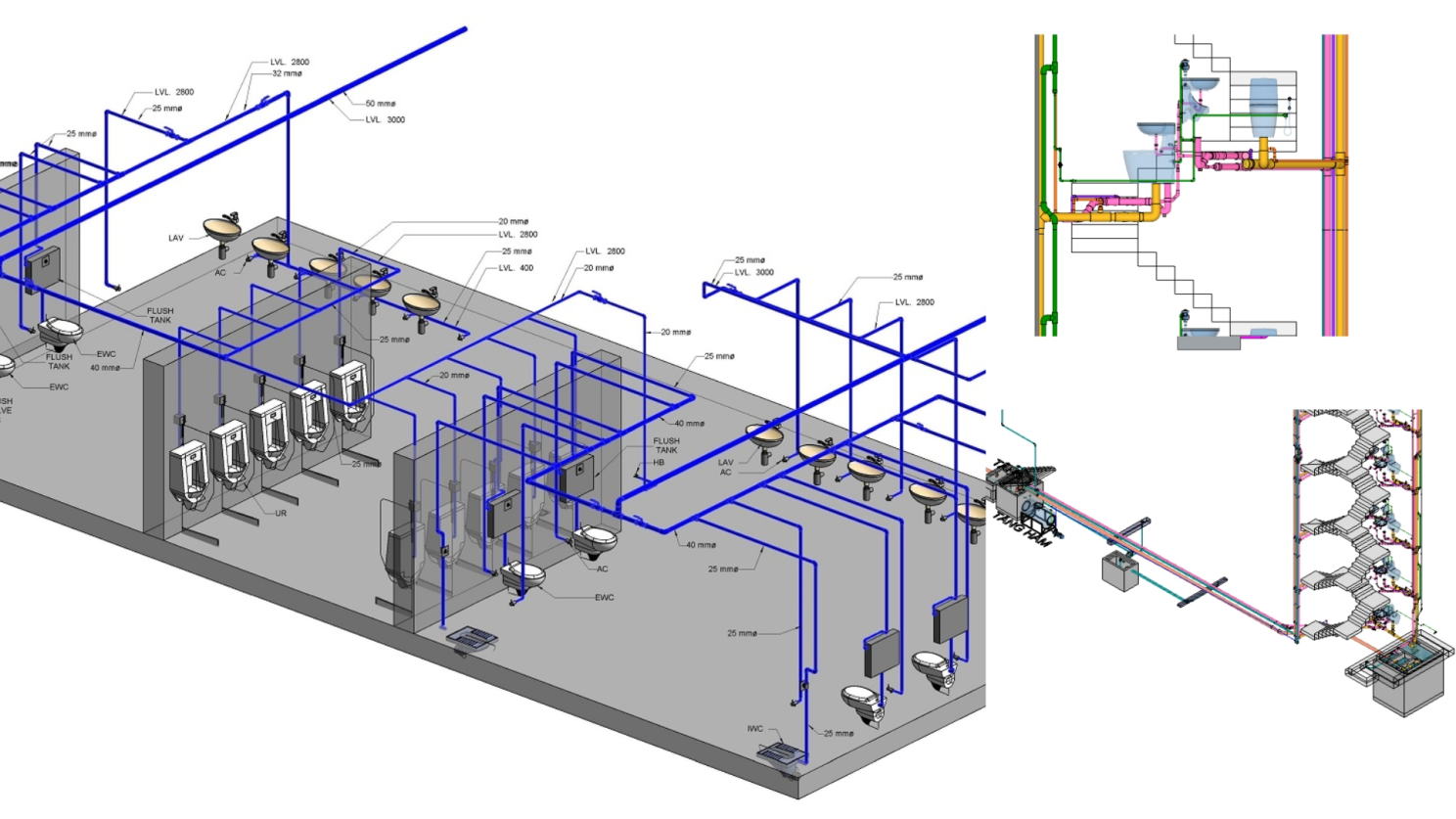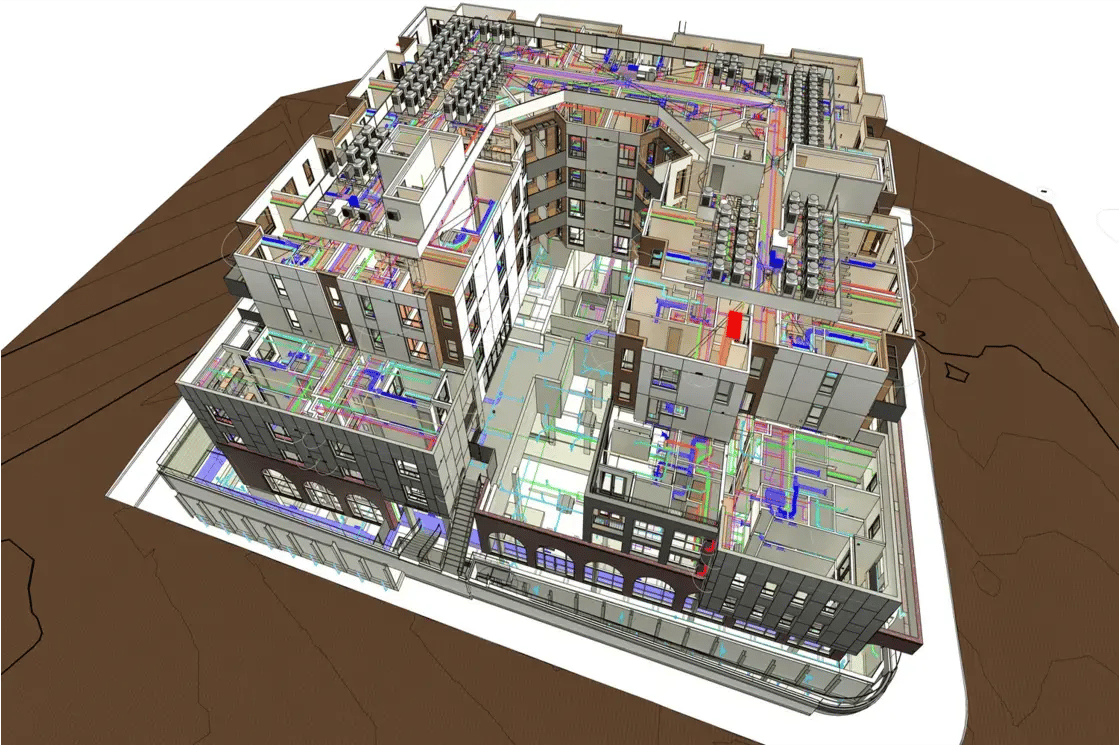.png)
Understanding the difference between OpenBIM and ClosedBIM is vital for engineers managing design and modeling across building systems. Each approach shapes how data is shared, tools interact, and workflows function in complex digital environments. For professionals overseeing technical models, effective MEP coordination ensures consistent communication and minimizes costly rework.
The choice between open and closed standards influences productivity, compatibility, and overall project results. OpenBIM promotes flexibility across platforms, while ClosedBIM provides controlled environments with limited integration. In the USA, the average BIM engineer salary is $116,463 per year, showing how technical proficiency supports evolving digital methods. These differences guide how teams handle design precision and coordination within construction project collaboration, impacting timelines, costs, and overall efficiency.
What Are OpenBIM and ClosedBIM, and How Do They Differ in Approach?
OpenBIM is a methodology that allows different software platforms to share and use model data efficiently. It relies on open file formats and standardized processes, helping teams maintain clear communication and consistency. ClosedBIM works within a single software environment, following strict BIM standards and protocols to manage data securely and uniformly, though it limits interaction with external platforms and broader collaboration.
Both methods shape how digital workflows are managed in projects. Below are six key ways they differ in approach:
-
Collaboration Scope: OpenBIM encourages cross-platform data sharing for broader participation, while ClosedBIM restricts exchange within its ecosystem.
-
Data Management Approach: ClosedBIM provides stronger data security, whereas OpenBIM prioritizes accessibility and open communication.
-
Team Involvement: OpenBIM allows input from multiple stakeholders, while ClosedBIM focuses on internal, controlled coordination.
-
File Handling System: ClosedBIM ensures uniform file organization through proprietary tools, while OpenBIM supports flexible formats.
-
Discipline Coordination: OpenBIM improves transparency in the role of MEP engineers in BIM project collaboration, strengthening multi-discipline integration.
-
Workflow Adaptability: ClosedBIM enables faster in-system integration, but OpenBIM allows greater flexibility for evolving project requirements.
Why Is Understanding These BIM Methodologies Important For MEP Engineers?

Understanding OpenBIM and ClosedBIM helps MEP engineers work efficiently with digital models, ensuring design accuracy and smooth information flow. OpenBIM enables cross-platform collaboration, while ClosedBIM offers controlled environments for consistent outputs; together, understanding both methodologies enhances planning, minimizes errors, and optimizes project timelines, leading to more precise technical decisions. It also strengthens MEP BIM workflows, improving overall team coordination.
Grasping BIM methodologies helps MEP engineers make informed decisions and navigate complex digital projects effectively:
-
Enhanced Decision-Making: Provides engineers with the knowledge to choose the best methods for designing and implementing systems, improving overall project outcomes.
-
Cross-Discipline Alignment: Ensures mechanical, electrical, and plumbing systems are coordinated accurately, reducing conflicts between different trades.
-
Process Efficiency: Streamlines project workflows, allowing engineers to complete tasks faster and minimize wasted effort or duplication.
-
Quality Control: Supports monitoring and verification of design standards throughout the project, maintaining consistency and compliance.
-
Traceable Project Changes: Keeps a detailed record of revisions and updates, allowing easy review and accountability for all project adjustments.
-
Integrated Coordination: Facilitates MEP coordination using OpenBIM and ClosedBIM, ensuring seamless interaction between systems and disciplines for smoother project execution.
Also Read: Top 50 MEP Interview Questions & Answers 2025
What Are the Benefits of Using OpenBIM for Collaboration and Interoperability?
OpenBIM enables seamless exchange of model data between different software platforms, allowing teams to work together efficiently without compatibility issues. It encourages transparent communication and coordinated workflows across multiple disciplines. By following standardized processes, teams can reduce errors, maintain consistency, and apply best practices for OpenBIM workflows in construction, ensuring smooth project execution.
Here are the advantages of using OpenBIM to improve teamwork and data integration:
-
Facilitates simultaneous work by multiple stakeholders, reducing delays and miscommunication.
-
Enhances overall design accuracy by enabling consistent model updates across platforms.
-
Improves coordination between architectural, structural, and MEP teams, supporting collaborative BIM design to minimize clashes and improve integration.
-
Supports BIM interoperability, allowing models to integrate smoothly across diverse software tools.
-
Provides transparent tracking of changes, ensuring accountability and easier review of revisions.
-
Streamlines information flow, helping teams make faster, informed decisions during project execution.
What Are the Advantages and Limitations of ClosedBIM in MEP Project Workflows?
ClosedBIM offers numerous benefits for managing MEP projects within a single software ecosystem, ensuring consistent outputs and controlled data handling. At the same time, it has certain limitations, such as reduced flexibility and limited integration with external tools. Understanding its framework supports effective use of digital construction technologies while balancing strengths and constraints in project workflows.
Here are the benefits of ClosedBIM in project-specific workflows:
-
Ensures consistent data management, reducing errors caused by incompatible file formats.
-
Provides a secure environment for sensitive project information.
-
Standardizes processes within the software, improving internal team efficiency.
-
Simplifies quality control with uniform model outputs across all design elements.
-
Reduces the learning curve for teams already familiar with the proprietary software.
Limitations of ClosedBIM in large-scale projects are as follows:
-
Restricts integration with external software, limiting collaboration with other teams.
-
Reduces flexibility for changes that require cross-platform coordination.
-
It can create bottlenecks when multiple disciplines need simultaneous input.
-
Limits access to evolving standards and best practices outside the ecosystem.
-
Increases dependency on a single software provider, risking project delays if issues arise.
How Do OpenBIM and ClosedBIM Impact Coordination, Design Accuracy, and Project Efficiency?

OpenBIM and ClosedBIM play a critical role in how teams coordinate, maintain design accuracy, and manage project timelines. OpenBIM allows multiple platforms to interact seamlessly, while ClosedBIM provides controlled, consistent outputs. Proper use of either method enhances workflow reliability and reduces errors. Adoption of modern MEP software further supports efficient integration across all project stages.
Key impacts of these methodologies include:
-
Improved Communication: Reduces misunderstandings and ensures all team members are aligned on project changes.
-
Clash Prevention: Early detection of design conflicts minimizes rework and construction delays.
-
Consistent Quality: ClosedBIM provides standardized outputs, maintaining uniformity in documentation and models, which benefits BIM for MEP engineers in project accuracy.
-
Enhanced Collaboration: Shows how OpenBIM improves collaboration for MEP engineers, enabling multi-discipline coordination across platforms.
-
Time Efficiency: Streamlined workflows reduce unnecessary steps, improving overall project delivery speed.
-
Accurate Decision-Making: Access to reliable and updated model data supports better planning and technical choices, enhancing project outcomes.
Also Read: How to transition from Mechanical Engineer to BIM Mechanical Engineer
Conclusion
Understanding the differences between OpenBIM and ClosedBIM is essential for improving coordination, design accuracy, and workflow efficiency in complex projects. OpenBIM encourages flexibility and cross-platform interaction, while ClosedBIM ensures controlled, consistent outputs. Awareness of BIM interoperability challenges for MEP design helps engineers navigate these methodologies effectively, ensuring smoother project execution and better multidisciplinary integration.
For engineers seeking to enhance their expertise, the BIM Course for MEP Engineers, offered by Novatr, provides structured learning on these methodologies and digital construction technologies. Visit our resource page to access additional insights, tools, and references that support the practical application of OpenBIM and ClosedBIM in real-world MEP project workflows, optimizing both accuracy and team collaboration.
FAQs
1. What is the difference between OpenBIM and ClosedBIM?
Ans: OpenBIM allows data exchange across multiple software platforms, while ClosedBIM operates within a single proprietary ecosystem with controlled outputs.
2. How does OpenBIM benefit collaboration among MEP engineers?
Ans: OpenBIM benefits collaboration among MEP engineers by enabling seamless data sharing across teams. This shared access allows coordinated work between multiple disciplines without conflicts.
3. What are the limitations of ClosedBIM in MEP projects?
Ans: ClosedBIM restricts cross-platform integration and limits flexibility, making coordination and updates with external teams more challenging.
Was this content helpful to you



.jpg)



